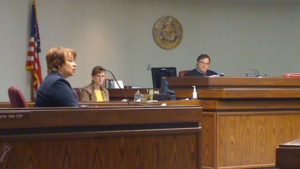The Process of Getting a Client’s Claim Ready Takes Focus and Effort
It is fair to wonder what it is that personal injury attorneys do. For good attorneys, the answer is deceptively simple: We get cases ready for trial. That does not mean your case is going to trial, just that it will be ready to go.
The difference between a good personal injury attorney and one who is just a “TV  Lawyer” is how your case is prepared. Good personal injury attorneys prepare to present evidence to a jury. Taking a case and trying to “just settle it” results in bad outcomes. Fair resolution of injury claims happens when your Idaho injury attorney establishes for the decision-makers at the insurance company that he is ready and able to actually try a case to trial if needed. And of course, trying cases to verdict if need be.
Lawyer” is how your case is prepared. Good personal injury attorneys prepare to present evidence to a jury. Taking a case and trying to “just settle it” results in bad outcomes. Fair resolution of injury claims happens when your Idaho injury attorney establishes for the decision-makers at the insurance company that he is ready and able to actually try a case to trial if needed. And of course, trying cases to verdict if need be.
When you hire lawyers like us with this approach it means that you have a chance to get fair payment for the injuries and losses imposed on you without filing suit. Or at least without trying the case. But, to get to that point, you want to hire an injury lawyer with a history of success. It takes time and years of experience to become leading injury lawyers. All the accolades our lawyers have received-they reflect that work. And, the work we have done in the past also benefits you today.
Step 1: Developing the Basic Facts
Getting ready to try a lawsuit has lots of parts. For example, in an initial meeting your lawyer will do an interview with you. This will be a “who, what, why, how and when” type of interaction. The attorney wants to get a basic understanding of how the injury occurred and what medical issues and life impacts followed from it.
The lawyer and his staff will also begin the process of gathering all the paperwork associated with the injury like police reports, witness statements, medical records and bills, and any other documents relevant such as background on the bad guy. Sometimes a more in-depth investigation requires interviews and some “sleuthing” to get all the facts.
After that initial information gathering, the lawyer identifies additional evidence needed to establish your case at trial. This can include video or pictures recorded witness interviews, government records or the like. It might require hiring an expert witness like an accident reconstructionist or a human factors engineer to prove what happened.
At the same time the lawyer can assist in dealing with the “who pays” issue that arises in an injury case. So there is a review of the available no-fault insurance, health insurance, liability insurance (including uninsured and under-insured motorist’s coverage) and disability insurance as well. There are often notice issues involved with insurance coverage either from the policy language of from cases like Miner v. Farmers Insurance Co., 116 Idaho 656 (1989).
The lawyer can them do a more in-depth background work up on the bad guy in cases where that is needed because of insurance shortfalls.
Step 2: Developing the Medical Facts
As the traumatic injury from the collision or medical malpractice begins to stabilize there is additional work to be done to ensure that the relevant facts can be proven to the jury if needed. Getting copies of all the client’s medical records related to the injuries and recovery is certainly part of that work.
But, being who and what they are, insurance companies and the lawyers the companies hire will always want to dig into your medical background. They will ALWAYS want to argue that whatever injury you have was really a pre-existing condition. Experienced injury lawyers get your past records to show the actual changes that are documented. Hopefully, the records are accurate but often, experience shows us, they are not. Doctors are not really trained to deal with the legal system and often leave out or overlook critical information that is needed to prove a case at trial. So another thing the lawyer needs to do is deal with the medical providers to address inaccuracies and to clarify missing information. This frequently requires personal interviews with physicians or an exchange of correspondence.
At this time, we evaluate whether your treating doctor will be a sufficient quality witness for you, or if a physician more familiar with both litigation and medicine needs to be hired to help in your case. Doctors, as a general rule, do not enjoy testifying. They would rather be providing treatment. But the insurance companies pay some of them very highly to testify against injured people. This means quality injury attorneys in Idaho have to evaluate whether to respond with medical professional more willing to engage in the litigation process.
Step 3: Addressing the Law
All the above is about dealing with the facts in the case. At the same time, good trial lawyers want to think through the legal issues in the case. This is to be sure that all the things that need to be proved at trial are covered. Also, if the situation has unique issues, the lawyer will do legal research to prepare for those that need to address at trial. This research is done through specialized legal research tools and often in conjunction with the legal librarians.
Step 4: Collaboration and Consultation
After all that work is done, there should be a meeting or discussion with the client  to make sure that he understands all the various issues: whether factual or legal. Often a decision can be made at this point whether a settlement “demand” is appropriate prior to filing a lawsuit or if simply filing the lawsuit makes more sense.
to make sure that he understands all the various issues: whether factual or legal. Often a decision can be made at this point whether a settlement “demand” is appropriate prior to filing a lawsuit or if simply filing the lawsuit makes more sense.
Step 5: Possibly Attempting Pre-Suit Resolution
If appropriate, compiling the legal and factual information into a comprehensive package discussing the legal theories and factual support for those theories in an effort at pre-suit settlement. In the situations where the case cannot be resolved or when a settlement approach before suit is ruled out, prepare a Complaint, file the lawsuit and have the Complaint and a Summons served upon the defendant.
Step 6: Driving the Litigation
From that point on the process is in litigation. This includes establishing schedules and deadlines for taking certain actions. And, getting a prompt trial date from the court.
Your lawyer will then work with you in the “discovery” process. This is a pre-trial exchange of information. An experienced personal injury attorney will have the vast, vast majority of the information to be provided to the insurance company lawyer already at hand because of the pre-suit work he has done. Discovery consists of the exchange of interrogatories (written questions), and requests for production (getting the other side’s documentary evidence). In addition, there are depositions (sworn testimony from witnesses).
Discovery can be the most times consuming of all the parts of litigation. Any good lawyer will work with you on making sure your deposition goes well and that your other discovery answers are appropriate.
In the trial preparation phase, there may be Motions filed with the court. Motions are a request that the court do or order some action. You may be forced to undergo an examination by insurance company bought and paid for doctors. You need to be prepared for that process as well.
During the discovery and pre-trial phase, there is often an opportunity to settle the case without trial as the facts are developed through discovery and the law is developed through motions.
Your lawyer has numerous documents such as pretrial briefs, proposed jury instructions and special motions about evidence (Motions in Limine) that are prepared as trial nears. In addition you and any witnesses such as people who have observed your injuries and recovery, or who saw the wreck or injury causing incident must again be prepared to testify at trial. And the lawyer also has to prepare to cross-examine the defendant’s expected witnesses.
Step 7: Trying the Case
After that it is time for trial. Trial consists of jury selection, opening statements, presentation of the plaintiff’s case in chief, presentation of defendant’s case, presentation of the plaintiff’s rebuttal case and closing arguments. In most injury cases, trial can last from a day or two to a week or two.
Trial can also be followed by appeals.
So that’s what your personal injury lawyer does for you–Oh and that’s the short version.
If you are anywhere in Idaho and want to discuss your potential personal injury lawsuit or claim, call us. The initial case review always free. And we work on a no recovery, no fee basis after that.


It is true that personal injury cases are associated with a lot of stress and negative emotions. This means that people who want to file a lawsuit should be aware of what to do in order to achieve success and get adequate compensation for their pain and suffering.